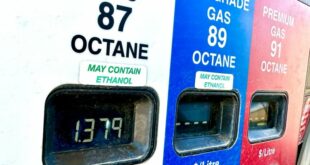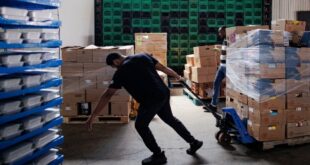Port authority head says Ontario companies are ‘craving’ the sweet supply.
A new sugar refinery set to open in Hamilton’s port lands in 2025 promises to be Canada’s largest, with capacity to produce 4,000 tonnes of refined sugar per day, or one million per year.
The Sucro Can Sourcing facility, at the foot of Hamilton’s Sherman Street North, will use Randle Reef as an active part of its operation.
The section of the harbour was once the most contaminated site on the Canadian side of the Great Lakes. A massive cleanup project began in 2016.
Its use for the new refinery signals the pending end of the process to dredge and enclose it, and then hand it over to the Hamilton Oshawa Port Authority (HOPA) to manage.
At a news conference Tuesday announcing details of the new operation, HOPA president and chief executive officer Ian Hamilton said the enclosed reef would be used as a “dock wall” for ships bringing sugar to the facility.
HOPA vice-president of corporate affairs Larissa Fenn told CBC Hamilton the contaminated area, which has been surrounded by walls and dredged, hadn’t been capped yet, but would be in time for the plant’s opening.
Plant to create 50 to 75 new jobs
Hamilton said the plant, which comes after a $135-million investment from Sucro Can and HOPA, could have a $1-billion ripple effect on Ontario’s economy, when it comes to other agri-food businesses choosing to locate near one of the country’s few sugar refineries.
“Many companies have been craving this kind of sugar supply,” he said, speaking in a Sucro Can building at the port, in front of a screen showing mesmerizing videos of construction machines digging in a mountain of sugar. Hamilton’s port already hosts about a dozen agri-food businesses, he said.
Sucro Can already runs a much smaller refinery in the Hamilton port lands, beside Collective Arts Brewery on Ferguson Avenue North. That operation, which produces about 100,000 tonnes a year and employs about 50 people, will be wound down once the new refinery opens around fall 2025, said Sucro Can founder and CEO Jonathan Taylor. Those employees will join 50 to 75 new workers at the larger facility, said Taylor.
He said the vast majority of sugar refined at the plant will be destined for Ontario’s growing agri-food sector, a factor that played into the decision to locate the plant in Hamilton.
“We’re not here to disrupt the market but will be capturing the growth going forward,” he said, while adding some refined sugar from Hamilton will also be destined for export.
Province pushing to move more goods on ‘H20 highways’
Florida-based Sucro Can was founded in 2014 and also runs a small refinery in New York state. The company’s website says its focus on improving its customers’ supply chains has been a key factor in its success.
Eastern Canada has two other sugar refineries, Redpath in Toronto and Rogers’s Lantic Sugar in Montreal.
Taylor said the company looked at several locations when deciding where to build the new facility, including a spot near the Welland Canal, but the company’s good relationship with HOPA — and easy access to rail, road and water transportation routes — helped seal the deal for Hamilton.
“The raw material comes in via water so the port is key,” he said. “The finished product moves on trucks locally, but if you want to go past 100 miles you want to be on rail, so we’re building massive rail infrastructure there.”

Minister of Agriculture, Food and Rural Affairs Lisa Thompson, who attended the event, said the Ontario government is making a “growing commitment” to moving more goods by ship on what she repeatedly called the province’s “H20 highways.” She said a new department has been created within the Ministry of Transportation to advance such goals.
“If we’re going to be effective, efficient and environmentally responsible as well, we have to get back to the multi-modal way of moving goods.”
Taylor said the project has not received any money from the province or federal government, but he is hopeful some support from both levels of government will come soon.
Company’s sugary emission in 2020 ‘shouldn’t happen’ again
Construction of the plant’s facilities will largely take place in the spring and summer, said Taylor, noting that once the plant’s exterior is built and enclosed, it should contain most of the construction sound.
Once operational, he said there shouldn’t be much of a smell from the facility, but that its location, “far enough away from any residential areas,” should limit any concerns.
“Look at who our neighbour is,” he said, gesturing at the nearby steel plants. “We’re so far away from anything, that was a key thing in choosing this place.”
The company’s Ferguson Avenue facility, which is much closer to residential areas, made headlines in 2020 when a filter malfunction led the factory to belch out a sugary film over parts of the North End. Taylor said the incident taught the company a few lessons.
“In that particular case, we do have a dry dust collecting system. The new system is a wet system,” he said. “These are things that you learn. That shouldn’t happen going forward.”
ABOUT THE AUTHOR
Saira Peesker is a reporter with CBC Hamilton, with particular interests in climate, labour and local politics. She has previously worked with the Hamilton Spectator and CTV News, and is a regular contributor to the Globe and Mail, covering business and personal finance. Saira can be reached at saira.peesker@cbc.ca.
*****
Credit belongs to : www.cbc.ca
 Atin Ito First Filipino Community Newspaper in Ontario
Atin Ito First Filipino Community Newspaper in Ontario





